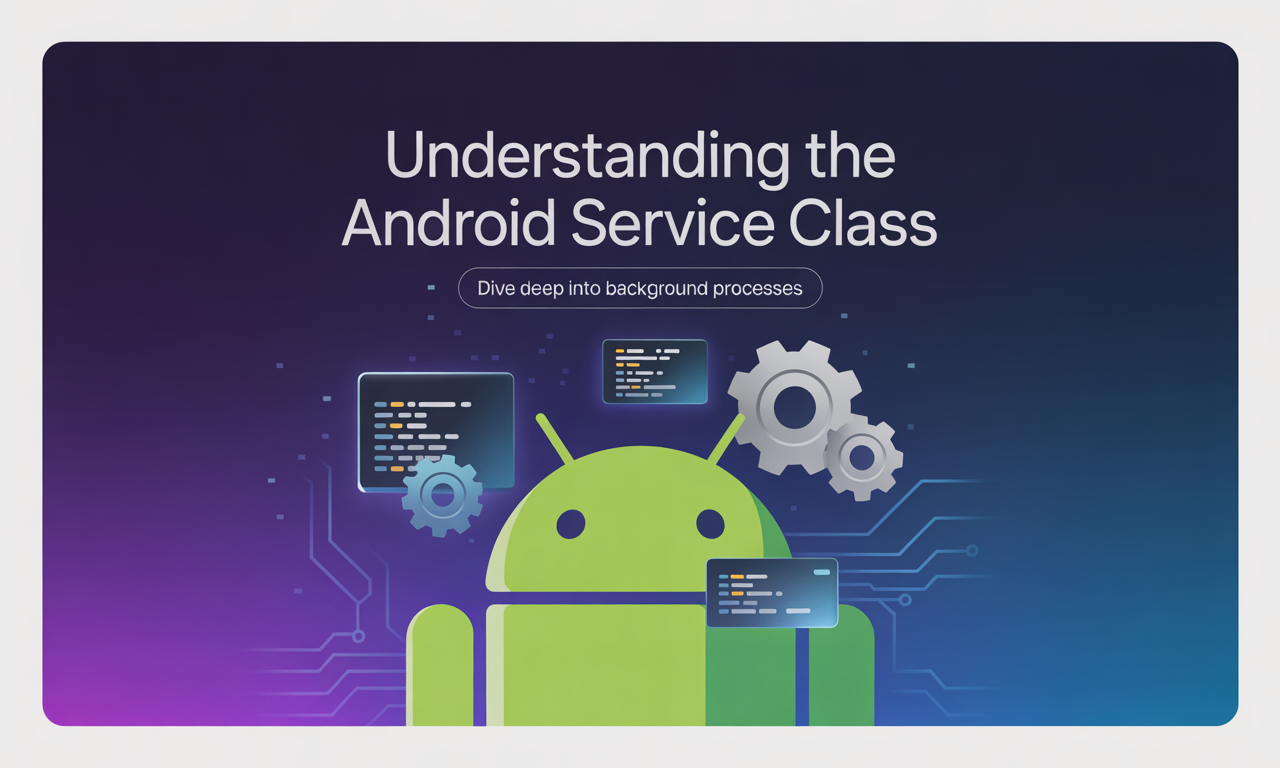Understanding the Android Service Class

If you’ve ever wanted your Android app to do something in the background like play music, download a file, or sync data without freezing the UI you've probably come across the Service class. It's one of the core components in Android development that lets you run long-running operations without user interaction.
In this post, I’ll walk you through everything you need to know about the Android Service class, including how to create one, start it from an Activity, and avoid common mistakes. Whether you're building a music player or handling network transactions, this guide will help you master background processing in Android.
What is the Android Service Class?
At its core, the Service class in Android is designed specifically for applications to initiate and perform background tasks. Unlike Activities, Services don’t have a user interface. They’re perfect for executing operations that take time, such as downloading files, playing audio, or syncing data with a server.
Fun fact: I once built a podcast app where I used a Service to manage audio playback in the background. Without it, the music would stop every time the user rotated their screen!
Here’s what a basic Service looks like:
public class MyService extends Service {
@Override
public void onCreate() {
super.onCreate();
// Service is being created
}
@Override
public int onStartCommand(Intent intent, int flags, int startId) {
new Thread(() -> {
// Your long-running task here
stopSelf(); // Stop service when done
}).start();
return START_STICKY;
}
@Override
public IBinder onBind(Intent intent) {
return null; // Not supporting binding
}
@Override
public void onDestroy() {
super.onDestroy();
// Clean up resources
}
}
This is a good starting point, but we'll go deeper into how each part works shortly.
Registering the Service in AndroidManifest.xml
Before you can use your Service, you need to declare it in the AndroidManifest.xml file:
<service android:name=".MyService"
android:exported="false" />
Setting android:exported="false" means only components within your app can start or bind to this Service. If you want other apps to interact with it, you’d set it to true, but that’s rarely needed unless you're building a system-level component.
Starting and Stopping the Service
Starting a Service is simple. From your Activity, just fire off an Intent:
Intent intent = new Intent(this, MyService.class);
startService(intent);
And if you want to stop it later:
stopService(new Intent(this, MyService.class));
Keep in mind that calling startService() multiple times doesn't create multiple instances it just calls onStartCommand() again with the new intent.
Types of Android Services
There are three main types of Services you should know about:
1. Started Service
A started service runs indefinitely until explicitly stopped. This type is ideal for one-off background tasks like downloading a file or syncing data.
You start it using startService(), and it stops itself by calling stopSelf() or another component calling stopService().
2. Bound Service
A bound service allows other components (like Activities or BroadcastReceivers) to bind to it and interact directly. For example, if you're building a music player, you might want to allow your UI to bind to the Service so it can control playback.
To support binding, you must override the onBind() method and return a Binder object.
3. Foreground Service
A foreground service is used for critical tasks that the user should be aware of. These services show a persistent notification and have higher priority in the system. Think of a music player or a GPS tracker.
To make a foreground service, call startForeground() inside onStartCommand():
Notification notification = new Notification.Builder(this, CHANNEL_ID)
.setContentTitle("Foreground Service")
.build();
startForeground(1, notification);
Common Mistakes to Avoid with the Android Service Class
Even experienced developers sometimes fall into traps when working with Services. Here are some common mistakes to watch out for:
Running Heavy Work on the Main Thread
By default, all Service code runs on the main thread. That means if you're doing something like parsing large JSON responses or compressing images, your app could ANR (Application Not Responding).
Fix: Always spawn a new thread or use IntentService or WorkManager for background work.
Forgetting to Stop the Service
If you forget to call stopSelf() or stopService(), your Service will keep running indefinitely even after the task is done. This leads to memory leaks and unnecessary battery drain.
Fix: Call stopSelf() when your task finishes, especially in onStartCommand().
Misusing Lifecycle Methods
The Service lifecycle (onCreate(), onStartCommand(), onDestroy()) is different from an Activity’s. Don’t assume they behave the same way.
Fix: Understand the lifecycle thoroughly and test edge cases like device rotation or low-memory situations.
Ignoring Foreground Requirements
From Android 8.0 (API level 26), background services have stricter limitations due to battery optimizations. If your Service needs to run continuously, consider making it a foreground service instead.
Best Practices for Using the Android Service Class
Here are a few tips based on my experience and current Android standards:
- Use
IntentServicefor simple, one-time background jobs. It automatically creates a worker thread and stops itself after execution. - Prefer
WorkManagerfor deferrable tasks that need guaranteed execution even if the app exits. - Use
Bound Serviceswhen you need two-way communication between components. - Always handle permissions properly, especially for foreground services which require
FOREGROUND_SERVICEpermission in the manifest. - Test your Service under real-world conditions low connectivity, low battery, etc. to ensure robustness.
Conclusion
The Android Service class is a powerful tool for managing background operations in your app. Whether you're downloading files, playing music, or syncing data, understanding how to use Services effectively can make your app faster, smoother, and more reliable.
I hope this guide helps you get started with Services or improve your existing implementation. If you found this helpful, check out our other posts on Android architecture components like ViewModel, LiveData, and WorkManager for modern alternatives to background processing.
Got questions or improvements? Drop a comment below! 👇